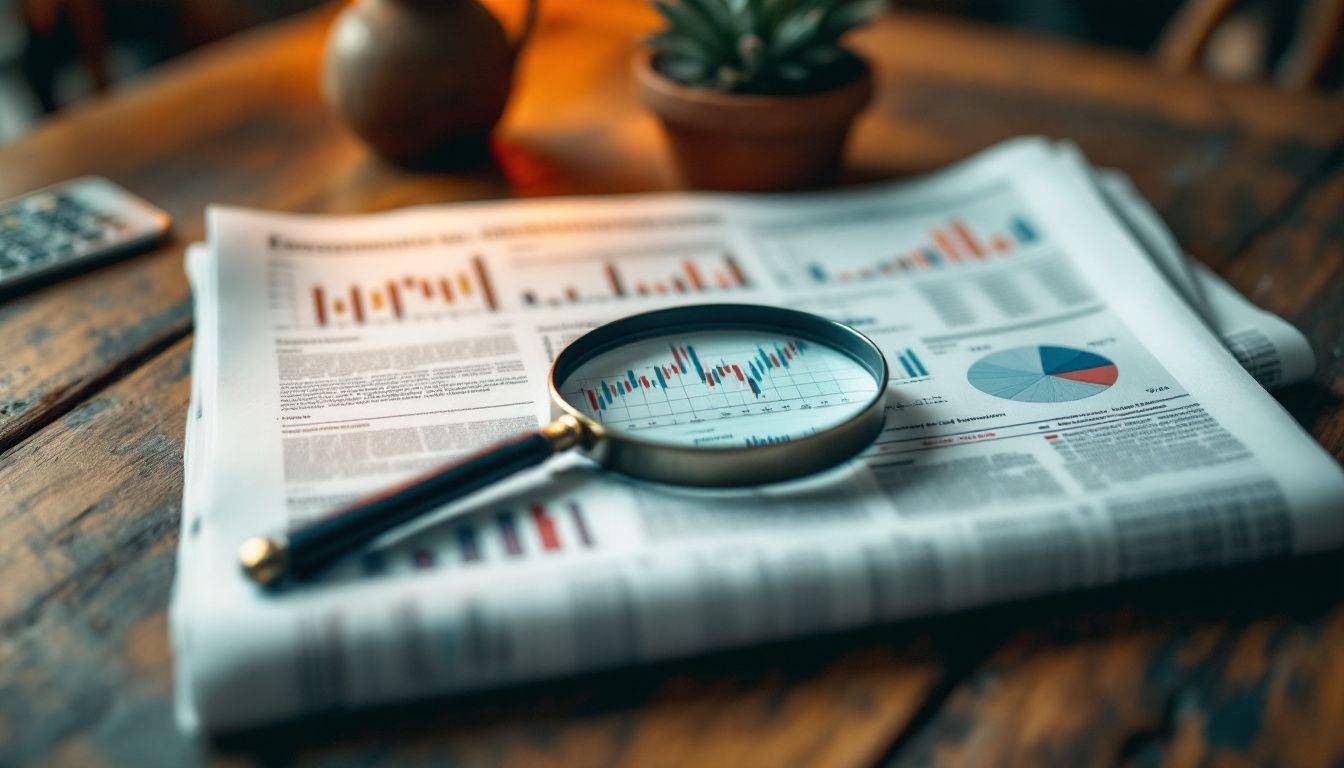Have you ever wondered about the dance of gold prices and what makes them move? Many folks find it tricky to grasp how economic indicators swing the gold rate today. But, guess what? It’s not magic.
It’s all about understanding the push and pull in the market.
Here’s an interesting fact: Gold has been on a losing streak for six days straight! Why is this happening? Much of it boils down to the US Dollar getting stronger. When dollars flex their muscles, gold often takes a back seat.
This article is your guide to making sense of those confusing numbers and trends. We’ll show how using economic signs can help predict where gold prices might head next. Ready to get smarter with your investments? Read on!
Key Economic Indicators Influencing Gold Rates

Alright, so you want to know what moves the gold rates? Think about it like a game where the US dollar and treasury promises play big roles. The Federal Reserve’s choices and how much stuff costs also have their say.
It’s like watching a sports match, but instead of balls and goals, we’ve got dollars, promises from the government, big bank decisions, and price tags doing all the action. Keep an eye on these players; they’re always up to something interesting!
US Dollar Strength
The US Dollar is really strong right now. It jumped to about 102.70 on the US Dollar Index (DXY). This is big news for gold prices. You see, when the dollar climbs up, the price of gold often goes down.
That’s exactly what happened recently—gold fell for six days in a row.
A strong dollar sends gold prices down.
Investors keep an eye on this dance between the dollar and gold. If you’re trading or investing in gold, watching the US currency helps you guess where gold rates might head next. It’s like a signal: if the dollar keeps winning, expect some tough times for gold prices.
Treasury YieldsTreasury yields are like a magic mirror that shows how the gold market might move. Think of them as interest from government debt papers, which investors watch closely. Right now, the 10-year Treasury yield is around 4.02%.
It’s close to its highest point in two months. This detail matters a lot for gold prices.
Higher yields mean people can get more money from these debts without risking it in gold. So, when yields go up, less people want to buy gold. This can make gold prices fall. Investors keep an eye on this dance between yields and gold rates to make smart choices about where to put their money.
Federal Reserve Rate Decisions
The Federal Reserve (Fed) makes big choices on interest rates. These decisions can change gold prices a lot. For example, if the Fed cuts rates, it often means gold prices go up. History shows us this pattern.
After the first cuts in 2001, 2007, and 2019, gold prices went higher. Next time you hear about the Fed planning to cut rates by 50 basis points in November, think about what it could mean for gold.
Gold investors keep an eye on these changes closely because they guide where gold might head next. Understanding how the Fed’s choices move markets helps traders make smarter choices with their money.
Now, let’s talk about inflation rates and how they play into all of this too.
Inflation Rates
Inflation makes things cost more. This includes gold. Analysts say when prices go up, so does the cost of gold. This is because the US Dollar drops in value. It’s a bit like a teeter-totter; as inflation goes up, the dollar goes down, and gold climbs higher.
Higher inflation often means higher gold prices.
Investors watch this dance closely. They use tools like inflation expectations and economic forecasts to guess where gold will go next. Central banks do too. When they see inflation rising, sometimes they buy more gold to keep their money safe.
So, keeping an eye on inflation can give traders clues about future moves in the precious metal market.
Recent Trends in Gold Prices

Gold prices have been on a wild ride, folks. They go up and down like a seesaw because of things like the US economy and what big banks do with their gold stash. People buying into gold funds also shake things up.
So, if you want to know why your gold investment is acting all moody, keep reading!
Impact of US Economic Data ReleasesUS economic news packs a big punch in the gold market. Take the recent Nonfarm Payrolls (NFP) data, for example. It showed strong job growth and higher wages. This kind of information gets traders and investors buzzing.
They see it as a sign of a healthy economy. A strong economy often means less gold buying. Why? People feel safe with stocks and cash when things look good.
But there’s more to it than just feeling safe or scared about the economy’s health. Gold prices move when the US releases this data because it can hint at future moves by the Federal Reserve—like interest rate changes.
If rates go up, gold might become less attractive because you can’t earn interest on it like you can with savings accounts or bonds. So, keeping an eye on these releases is key for anyone wanting to make smart moves in forex markets or with investments in gold bullion or futures exchanges.
Central Bank Gold Reserves Updates
Central banks have been busy with gold. In 2023, they bought a lot of it – 1,037 tonnes to be exact. Then, in the first quarter of 2024, they added another 290 tonnes to their piles.
This shows they think gold is important and want more of it.
Why do central banks buy so much gold? It’s simple. Gold is like a safety net for them. When things get shaky with money or markets, having gold makes them feel safer. By keeping more gold, these banks are preparing for anything that could happen in the future.
ETF Inflows and OutflowsETF inflows and outflows significantly influence gold prices. If a surge of investors funnel more resources into gold ETFs, it suggests a positive outlook for gold, leading to escalated demand and prices.
Conversely, if investors begin to withdraw their investments, it implies potential concerns that can lead to a decrease in gold’s price.
Consider each time there’s a substantial alteration in these inflows or outflows; attentive observers include those engaged in forex markets like XAUUSD or those involved with commodities on exchanges.
Such adjustments provide traders with insights into potential trajectories for gold. Hence, monitoring ETF movements is crucial for individuals interested in investing or trading gold effectively.
As we proceed, we’ll understand how analyzing support and resistance levels can further clarify potential future price trends in the market.
Technical Analysis of Gold Prices

Within the scope of gold trading, analyzing charts and graphs is crucial. Traders apply factors like “support and resistance levels” to estimate future gold prices. They also examine previous price movements and trading volumes to make intelligent decisions. Consequently, they aim to identify patterns that might indicate whether gold prices will increase or decrease.
Support and Resistance Levels
The levels help us see where gold prices might stop falling or rising. Support is like a floor where the price finds it hard to break through and go lower.
Resistance is like a ceiling that keeps prices from going higher easily.
Investors watch these closely because past these points; big changes can happen.
Price Trends and Patterns
Gold prices show patterns that traders and investors can watch. Recently, gold fell to $2,620 from a high of $2,685. The 20-day Exponential Moving Average (EMA) is now at $2,615 while the 50-day EMA sits lower at $2,550.
These numbers tell us where gold might head next.
Watching the EMA can give clues about future price moves.
Patterns like these help in making predictions. For example, if gold stays above its 20-day EMA for a few days, it might mean prices will go up. But if it drops below the 50-day EMA, we could see more drops ahead.
Keep an eye on these trends!
Volume AnalysisVolume analysis tells us if a gold price move is strong or weak. Think of it like checking the crowd at a market to see how popular something is. If lots of people are buying or selling gold, the volume is high.
This means the price movement has big support and might keep going. But if few are trading, even with a big price change, we doubt it will last.
We use tools like charts and numbers from places like Commodity Exchange to study this. We look at past trends, too. So, investors in things like gold ETFs (Exchange-Traded Funds) pay close attention to volume alongside prices.
They want to make smart choices based on strong signals.
Next up, let’s talk about fundamental analysis of gold prices…
Fundamental Analysis of Gold Prices

Exploring gold investing, fundamental analysis is akin to wearing detective spectacles. You consider overarching themes—nation’s performances, authoritative bank statements, and concerns about potential inflation.
This process involves drawing connections between global occurrences and their impact on gold’s value. Hence, you immerse yourself in reports from respected institutions such as the World Bank and monitor the actions of significant banking players like J.P. Morgan or Goldman Sachs. Also, be sure to verify the gold reserves of different countries! This approach provides a dependable hint about the potential direction of gold prices without any need for fortune-telling.
Safe-Haven Demand
Gold shines during hard times. Think about it like a safe place in a storm. When the world feels unsure—maybe because of wars or bad news in big countries’ money plans—people run to gold.
It’s like an insurance against trouble. This habit isn’t new; it’s been around for ages.
In times of uncertainty, gold is not just a metal, but a guardian.
Central banks across the globe keep gold for this reason too. They know when their own money loses value, gold won’t let them down. With every scare from things happening around the world, whether fights between countries or big changes in how much things cost, more people and places want to have gold in their hands.
Watching these moves can help you guess where gold prices might go next.
Global Macroeconomic Factors
Shifting from the concept of gold as a reliable investment, substantial global economic factors bear significant influence as well. Elements such as inflation and economic instability may escalate the demand for gold.
When currency value depreciates or there’s a drastic shift in the cost of goods, individuals may be inclined to purchase more gold. This is largely due to their concerns and the perception of gold as a stable asset under any circumstance.
Major policies by entities like the Federal Reserve in the U.S. or other central banks globally can also steer people to gold. If these bodies declare that they will tighten their lending practices or anticipate a rise in commodity prices, it positions gold as more attractive for investment.
Thus, close monitoring of these substantial moves can assist traders in predicting possible future trends in gold prices.
Political Events
Political happenings can really shake up the gold market. The death of Hezbollah’s leader made tensions between Israel and Iran-backed Hezbollah worse. This kind of news makes people nervous about the future.
When folks feel unsure, they often turn to gold as a safe place for their money. Because of this, events around the world that cause worry can push more people to buy gold. This demand then drives up the price of gold in places like Dubai, UAE, and Saudi Arabia.
Big changes on the political scene are important for traders and investors to watch. Keeping an eye on these shifts helps them make smart choices about when to buy or sell gold. By understanding how such events impact safe-haven assets like gold, investors can better predict future price movements and protect their portfolios during times of economic uncertainty or crisis.
Predicting Gold Prices Using Economic Indicators
To guess where gold prices might go, we look at things like the economy and big bank decisions. We use math models, look at past price moves, and think about what’s happening in the world to make our best guess.
Ready to learn more?
Correlation Analysis
Alright, folks, let’s examine correlation analysis without making your head spin. Imagine you’re trying to understand how gold moves. It’s like trying to predict the weather, but instead of examining clouds, you’re examining numbers. You’re not alone in this. Traders and investors are passionate about this.
Here’s a clear table to explain:
| Economic Indicator | Relation to Gold Prices |
|---|---|
| US Dollar Strength | Negative |
| Treasury Yields | Usually Negative |
| Federal Reserve Rate Decisions | Mixed, depends on the decision |
| Inflation Rates | Positive |
| ASX, S&P500, TA35, IBEX, AEX Indices | Varies, often negative |
| U.S. and Japan Bond Yields | Mostly Negative |
| Gas Prices | Varies |
| Silver Prices | Positive |
So, what do all these details suggest? If the US dollar is strong, gold usually falls. They behave like a seesaw, with one rising as the other falls. Treasury yields and gold? They have a complex relationship. Higher yields often result in lower gold prices, but the influence isn’t always straightforward. Inflation and silver prices, on the other hand, tend to support gold prices. Consider them as supporting players for gold.
Now, those indices such as ASX, S&P500, and others? Their relationship with gold can be unpredictable. Sometimes they move in tandem; other times, they go their separate ways. It’s like guessing your cat’s next move. And consider gas prices. They have a complex interaction with gold. Sometimes they align, and other times they diverge.
So, what should an investor do with all this information? Monitor these indicators closely. They’re like guideposts on your journey to making knowledgeable decisions. The market constantly brings unexpected challenges. Just when you think you understand it, it can surprise you.
Regression ModelsRegression models are a trader’s best friend for forecasting gold prices. Think Random Forest, Gradient Boosted Regression Trees (GBRT), and Extreme Gradient Boosting (XGBoost). These machine learning tools look at past data and economic signs to predict where gold might head next.
It’s like having a crystal ball, but instead of magic, it uses math and computers.
For example, these models take numbers from the past—like what the Federal Reserve did or how the US dollar behaved—and crunch them to see patterns. Then they use these patterns to make educated guesses about future gold prices.
It’s not perfect, but it gives traders a way to use history to guess what might happen tomorrow.
In investing, knowing the path ahead is half the battle won.
Moving on to understanding how market sentiment plays into all of this.
Forecasting Techniques
Moving from regression models, we step into the zone of forecasting techniques. These methods help investors see where gold prices might head.
- Correlation Analysis – This looks at how gold prices move with other variables. For example, if the US dollar gets strong, gold often falls. Think of it like a dance between prices and factors like the VIX score, or how calm or scared the financial markets are.
- Time Series Models – These use past gold price data to guess future prices. Investors can look at patterns over days, months, or years to make their bets.
- Moving Averages – This technique smooths out price data to spot trends. If the current price is above its moving average, it could mean a bullish trend (think prices going up).
- Momentum Indicators – Tools like the Relative Strength Index (RSI) show if gold is overbought or oversold. It’s a bit like checking if gold is too hot or too cold and betting on it finding a comfy middle.
- Sentiment Analysis – Some traders scan news articles, social media buzz, and economic reports to gauge feelings about gold. Positive news could push prices up; bad news might drag them down.
- Economic Indicators – Traders watch for changes in inflation rates, central bank decisions, and other major economic signs that can sway gold rates.
- Expert Predictions – People also pay attention to forecasts from big names like Goldman Sachs or the International Monetary Fund (IMF). Though not always right on the money (pun intended), these predictions draw from deep analysis.
Investors mix these techniques with their knowledge of market sentiment and financial tools to guess where gold prices will go next. Each approach adds a piece to the puzzle of understanding future price movements in forex market analysis and more broadly in financial markets.
Practical Tips for Investors
Keep an eye on global news, folks. It can tell you a lot about where gold prices might head next. And don’t forget to check out financial websites and apps. They are your best friends for making smart moves in the market.
Monitoring Economic News
To stay ahead in gold trading, watching economic news is key. The Federal Open Market Committee (FOMC) meeting minutes give us hints about future monetary policy. This can affect gold prices a lot.
Also, updates from the World Gold Council (WGC) show us how much gold central banks are buying or selling. These actions can push the price of gold up or down.
Use tools like financial news websites and trading platforms to catch this data quickly. They offer insights into US dollar strength, treasury yields, and inflation rates—all important for predicting gold rate changes.
Staying updated helps traders make smart moves fast, keeping them one step ahead in the game of investing in gold.
Understanding Market Sentiment
Market sentiment is like a mood ring for the stock market. It shows how traders and investors feel about gold prices today. They might hear news about geopolitical tensions or see changes in central bank gold reserves.
This news makes them act, buying more gold if they’re worried or selling it if they’re feeling good about other investments.
Tools like sentiment analysis help us catch these mood swings. They look at loads of data from social media, news stories, and investment trends to say if people are bullish (thinking prices will go up) or bearish (thinking prices will go down).
Watching these tools can give you clues on when to buy or sell gold. Now, let’s talk practical tips for using this info as an investor.
Utilizing Financial Tools and Platforms
For traders and investors, keeping on top of gold rates is key. Using online tools like “contracts for difference” (CFDs) platforms can help. These platforms give real-time data and advanced charts.
This way, you can see how gold prices move in the moment. Also, you can use apps that track global inflation and exchange rates to understand broader impacts.
Some tools offer technical analysis features. They show support and resistance levels or predict future movements using past trends. By mixing these insights with recent economic news from reliable sources—like the US Federal Reserve or London Bullion Market Association—you get a fuller picture of where gold might head next.
Next up: Expert predictions for 2024 will shed more light on how all these factors come together.
Future Outlook on Gold Prices
Peeking into the future of gold prices feels like looking through a crystal ball. Experts with their charts and models, such as regression analysis and forecasting methods, try to give us a sneak peek at what might happen after 2023.
It’s all about connecting dots between global events and those shiny bars or coins we call gold. Will the price go up or down? Keep an eye on big bank moves and worldwide news; they hold clues!
Expert Predictions for 2024 and Beyond
Experts like J.P. Morgan and Goldman Sachs have big thoughts on gold’s future prices. J.P. Morgan sees it hitting $2,500 per ounce by the end of 2024. Goldman Sachs goes even further, predicting $2,700 per ounce by the same time.
These forecasts suggest a bright outlook for gold investors.
Thinking about these predictions helps us see where the market might head. Big banks use lots of data and trends to make their guesses. This makes their predictions helpful for anyone looking to invest in gold or diversify their portfolio with something solid like bullion or futures contracts related to non-yielding bullion and currencies like the United States dollars.
Potential Market Movements
Gold rates could rise or fall due to different factors. If the Federal Reserve cuts interest rates, history shows gold prices might go up. This is something traders keep an eye on.
They also watch how the US dollar does against other money systems. A strong dollar usually means lower gold prices.
Investors use tools like regression models and forecasting techniques to guess where gold prices will head next. They look at things like inflation rates and how much gold central banks are buying or selling.
Big events in politics or changes in the global economy can shake things up too.
So, keeping a close watch on these indicators helps people make smarter choices about buying or selling gold as part of their investment strategy. It’s all about trying to stay one step ahead in the game.
Economic Scenarios Impacting Gold
Large-scale financial institutions like World Bank, IMF, Goldman Sachs, and Morgan Stanley hold optimistic views for gold. They anticipate prices to escalate significantly by 2024.
Potential estimates range from $2,450 to a striking $2,700! The underlying reason? It’s primarily due to the increased gold consumption by central banks and global financial uncertainties.
The actions of these influential institutions are closely monitored as their strategies can prompt swift variations in regions like the UAE or Saudi Arabia, where gold holds considerable importance.
Central banks acquiring more gold signals their apprehension regarding future predictions. It implies that perhaps we should remain vigilant for any abrupt fluctuations in price. Thus, moving forward, let’s examine the implications of this scenario if you contemplate venturing into trading or investment in gold.
Conclusion
We discussed the influence of economic indicators on gold prices. Factors such as the strength of the dollar, treasury yields, Federal Reserve decisions, and inflation are all key determinants of gold rates.
We observed recent trends, such as the impact of US data disclosures and bank actions on gold. Technical viewpoints, utilizing charts, suggest potential future price paths. Fundamental considerations involve security concerns and global issues prompting the purchase or sale of gold.
Utilizing these indicators can aid in forecasting future gold prices. Instrumentation like correlation research and predictive models provide insight into possible future occurrences based on historical data.
Investors are recommended to be alert to news and employ market tools to stay well-informed.
Due to its distinctive role in financial systems, gold maintains its relevance in an intelligent investment portfolio. Specialists predict that gold will retain its worth in the future, notwithstanding fluctuations.
For prospective gold investors, initiating is less complicated than presumed with the correct resources. One golden rule to remember – always verify your information before proceeding with investment decisions!
So, prepared to manage your investments? The intriguing gold sector awaits!
FAQs
1. How do economic indicators predict the gold rate today?
Economic indicators like interest rate cuts, inflationary pressures, and monetary policy tightening can impact the price of gold. For instance, if there’s an increase in money supply or fears of deflation, people might turn to “safe haven” investments like gold.
2. Can global events affect the gold rate?
Absolutely! Events such as trade wars or new sanctions imposed on Russia can cause fluctuations in national currencies and foreign exchange rates which directly influence Gold Rate UAE, Dubai and Saudi Arabia.
3. How does central bank buying impact the gold price forecast?
Central banks play a big role here… When they buy more gold (like Reserve Bank or JPMorgan Chase & Co.), it increases demand and raises prices. It’s their way to hedge against currency devaluation.
4. Does portfolio diversification involve investing in Gold?
You bet it does! Including assets like Gold in your portfolio is a common strategy for diversification – it helps balance out risks from other investments (like stocks or bonds). Plus, with contracts for difference (CFDs), you could even earn passive income!
5. How reliable are predictions based on economic indicators for intraday trading?
Well… while these predictions provide useful insights into macroeconomic environment trends affecting Gold Price Analysis; remember that markets can be unpredictable – especially when looking at short-term trades!
6. What effect do liquidity issues have on predicting the future value of gold?
In times of economic crises where liquidity becomes scarce within global financial system; investors often flock to stable investments like Gold leading to increased prices – so yes, liquidity issues significantly affect our ability to predict future values.





